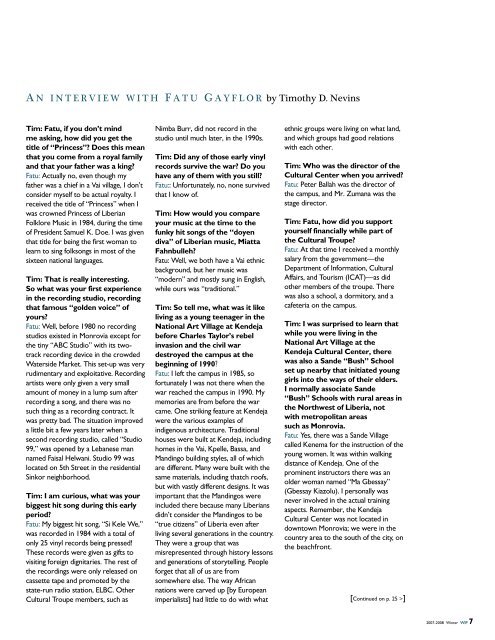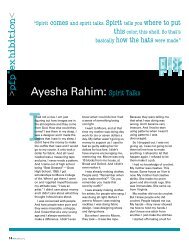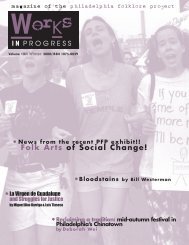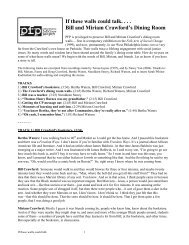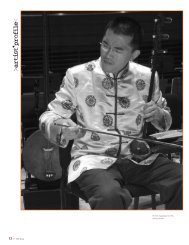African song / Fatu Gayflor ⢠War and wealth - Philadelphia Folklore ...
African song / Fatu Gayflor ⢠War and wealth - Philadelphia Folklore ...
African song / Fatu Gayflor ⢠War and wealth - Philadelphia Folklore ...
You also want an ePaper? Increase the reach of your titles
YUMPU automatically turns print PDFs into web optimized ePapers that Google loves.
A N INTERVIEW WITH F ATU G AYFLOR by Timothy D. Nevins<br />
Tim: <strong>Fatu</strong>, if you don’t mind<br />
me asking, how did you get the<br />
title of “Princess”? Does this mean<br />
that you come from a royal family<br />
<strong>and</strong> that your father was a king?<br />
<strong>Fatu</strong>: Actually no, even though my<br />
father was a chief in a Vai village, I don’t<br />
consider myself to be actual royalty. I<br />
received the title of “Princess” when I<br />
was crowned Princess of Liberian<br />
<strong>Folklore</strong> Music in 1984, during the time<br />
of President Samuel K. Doe. I was given<br />
that title for being the first woman to<br />
learn to sing folk<strong>song</strong>s in most of the<br />
sixteen national languages.<br />
Tim: That is really interesting.<br />
So what was your first experience<br />
in the recording studio, recording<br />
that famous “golden voice” of<br />
yours?<br />
<strong>Fatu</strong>: Well, before 1980 no recording<br />
studios existed in Monrovia except for<br />
the tiny “ABC Studio” with its twotrack<br />
recording device in the crowded<br />
Waterside Market. This set-up was very<br />
rudimentary <strong>and</strong> exploitative. Recording<br />
artists were only given a very small<br />
amount of money in a lump sum after<br />
recording a <strong>song</strong>, <strong>and</strong> there was no<br />
such thing as a recording contract. It<br />
was pretty bad. The situation improved<br />
a little bit a few years later when a<br />
second recording studio, called “Studio<br />
99,” was opened by a Lebanese man<br />
named Faisal Helwani. Studio 99 was<br />
located on 5th Street in the residential<br />
Sinkor neighborhood.<br />
Tim: I am curious, what was your<br />
biggest hit <strong>song</strong> during this early<br />
period?<br />
<strong>Fatu</strong>: My biggest hit <strong>song</strong>, “Si Kele We,”<br />
was recorded in 1984 with a total of<br />
only 25 vinyl records being pressed!<br />
These records were given as gifts to<br />
visiting foreign dignitaries. The rest of<br />
the recordings were only released on<br />
cassette tape <strong>and</strong> promoted by the<br />
state-run radio station, ELBC. Other<br />
Cultural Troupe members, such as<br />
Nimba Burr, did not record in the<br />
studio until much later, in the 1990s.<br />
Tim: Did any of those early vinyl<br />
records survive the war? Do you<br />
have any of them with you still?<br />
<strong>Fatu</strong>:: Unfortunately, no, none survived<br />
that I know of.<br />
Tim: How would you compare<br />
your music at the time to the<br />
funky hit <strong>song</strong>s of the “doyen<br />
diva” of Liberian music, Miatta<br />
Fahnbulleh?<br />
<strong>Fatu</strong>: Well, we both have a Vai ethnic<br />
background, but her music was<br />
“modern” <strong>and</strong> mostly sung in English,<br />
while ours was “traditional.”<br />
Tim: So tell me, what was it like<br />
living as a young teenager in the<br />
National Art Village at Kendeja<br />
before Charles Taylor’s rebel<br />
invasion <strong>and</strong> the civil war<br />
destroyed the campus at the<br />
beginning of 1990?<br />
<strong>Fatu</strong>: I left the campus in 1985, so<br />
fortunately I was not there when the<br />
war reached the campus in 1990. My<br />
memories are from before the war<br />
came. One striking feature at Kendeja<br />
were the various examples of<br />
indigenous architecture. Traditional<br />
houses were built at Kendeja, including<br />
homes in the Vai, Kpelle, Bassa, <strong>and</strong><br />
M<strong>and</strong>ingo building styles, all of which<br />
are different. Many were built with the<br />
same materials, including thatch roofs,<br />
but with vastly different designs. It was<br />
important that the M<strong>and</strong>ingos were<br />
included there because many Liberians<br />
didn’t consider the M<strong>and</strong>ingos to be<br />
“true citizens” of Liberia even after<br />
living several generations in the country.<br />
They were a group that was<br />
misrepresented through history lessons<br />
<strong>and</strong> generations of storytelling. People<br />
forget that all of us are from<br />
somewhere else. The way <strong>African</strong><br />
nations were carved up [by European<br />
imperialists] had little to do with what<br />
ethnic groups were living on what l<strong>and</strong>,<br />
<strong>and</strong> which groups had good relations<br />
with each other.<br />
Tim: Who was the director of the<br />
Cultural Center when you arrived?<br />
<strong>Fatu</strong>: Peter Ballah was the director of<br />
the campus, <strong>and</strong> Mr. Zumana was the<br />
stage director.<br />
Tim: <strong>Fatu</strong>, how did you support<br />
yourself financially while part of<br />
the Cultural Troupe?<br />
<strong>Fatu</strong>: At that time I received a monthly<br />
salary from the government—the<br />
Department of Information, Cultural<br />
Affairs, <strong>and</strong> Tourism (ICAT)—as did<br />
other members of the troupe. There<br />
was also a school, a dormitory, <strong>and</strong> a<br />
cafeteria on the campus.<br />
Tim: I was surprised to learn that<br />
while you were living in the<br />
National Art Village at the<br />
Kendeja Cultural Center, there<br />
was also a S<strong>and</strong>e “Bush” School<br />
set up nearby that initiated young<br />
girls into the ways of their elders.<br />
I normally associate S<strong>and</strong>e<br />
“Bush” Schools with rural areas in<br />
the Northwest of Liberia, not<br />
with metropolitan areas<br />
such as Monrovia.<br />
<strong>Fatu</strong>: Yes, there was a S<strong>and</strong>e Village<br />
called Kenema for the instruction of the<br />
young women. It was within walking<br />
distance of Kendeja. One of the<br />
prominent instructors there was an<br />
older woman named “Ma Gbessay”<br />
(Gbessay Kiazolu). I personally was<br />
never involved in the actual training<br />
aspects. Remember, the Kendeja<br />
Cultural Center was not located in<br />
downtown Monrovia; we were in the<br />
country area to the south of the city, on<br />
the beachfront.<br />
[Continued on p. 25 >]<br />
2007-2008 Winter WIP 7


